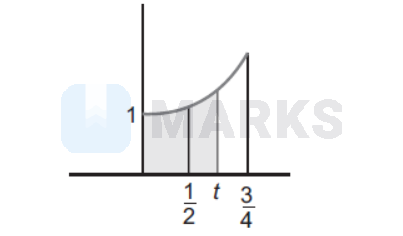Search any question & find its solution
Question:
Answered & Verified by Expert
Paragraph:
Consider the polynomial $f(x)=1+2 x+3 x^2+4 x^3$. Let $s$ be the sum of all distinct real roots of $f(x)$ and let $t=|s|$.Question:
The area bounded by the curve $y=f(x)$ and the lines $x=0, y=0$ and $x=t$, lies in the interval
Options:
Consider the polynomial $f(x)=1+2 x+3 x^2+4 x^3$. Let $s$ be the sum of all distinct real roots of $f(x)$ and let $t=|s|$.Question:
The area bounded by the curve $y=f(x)$ and the lines $x=0, y=0$ and $x=t$, lies in the interval
Solution:
1478 Upvotes
Verified Answer
The correct answer is:
$\left(\frac{3}{4}, 3\right)$
$\left(\frac{3}{4}, 3\right)$
$\int_0^{1 / 2} f(x) d x < \int_0^t f(x) d x < \int_0^{3 / 4} f(x) d x$ Now, $\int f(x) d x$
$$
\begin{gathered}
=\int\left(1+2 x+3 x^2+4 x^3\right) d x \\
=x+x^2+x^3+x^4 \\
\Rightarrow \quad \int_0^{1 / 2} f(x) d x=\frac{15}{16}>\frac{3}{4} \\
\int_0^{3 / 4} f(x) d x=\frac{530}{256} < 3
\end{gathered}
$$

$$
\begin{gathered}
=\int\left(1+2 x+3 x^2+4 x^3\right) d x \\
=x+x^2+x^3+x^4 \\
\Rightarrow \quad \int_0^{1 / 2} f(x) d x=\frac{15}{16}>\frac{3}{4} \\
\int_0^{3 / 4} f(x) d x=\frac{530}{256} < 3
\end{gathered}
$$
Looking for more such questions to practice?
Download the MARKS App - The ultimate prep app for IIT JEE & NEET with chapter-wise PYQs, revision notes, formula sheets, custom tests & much more.